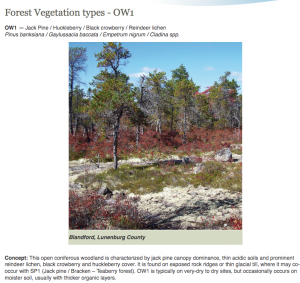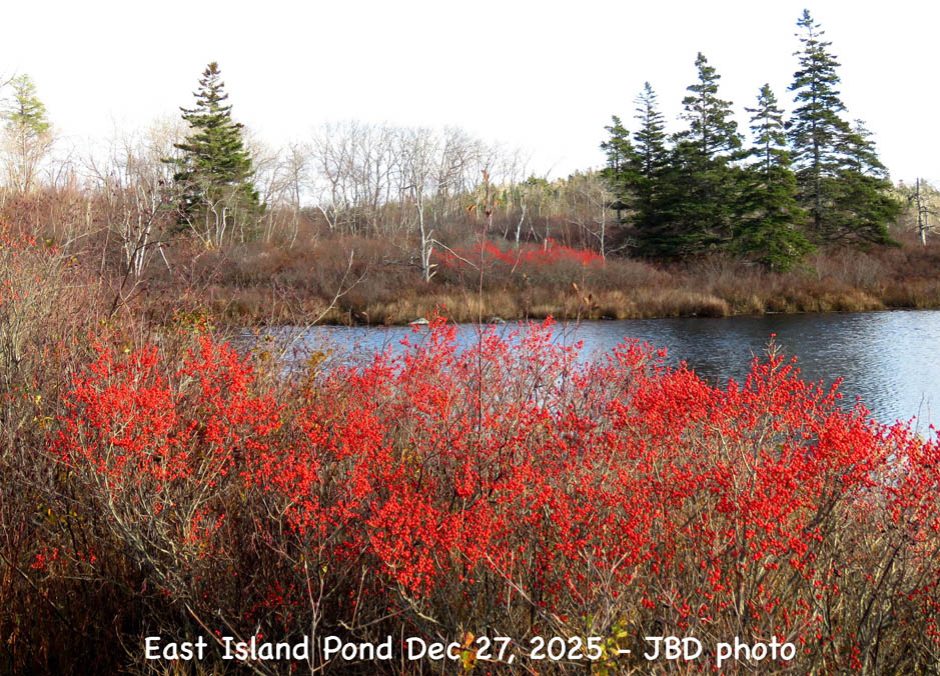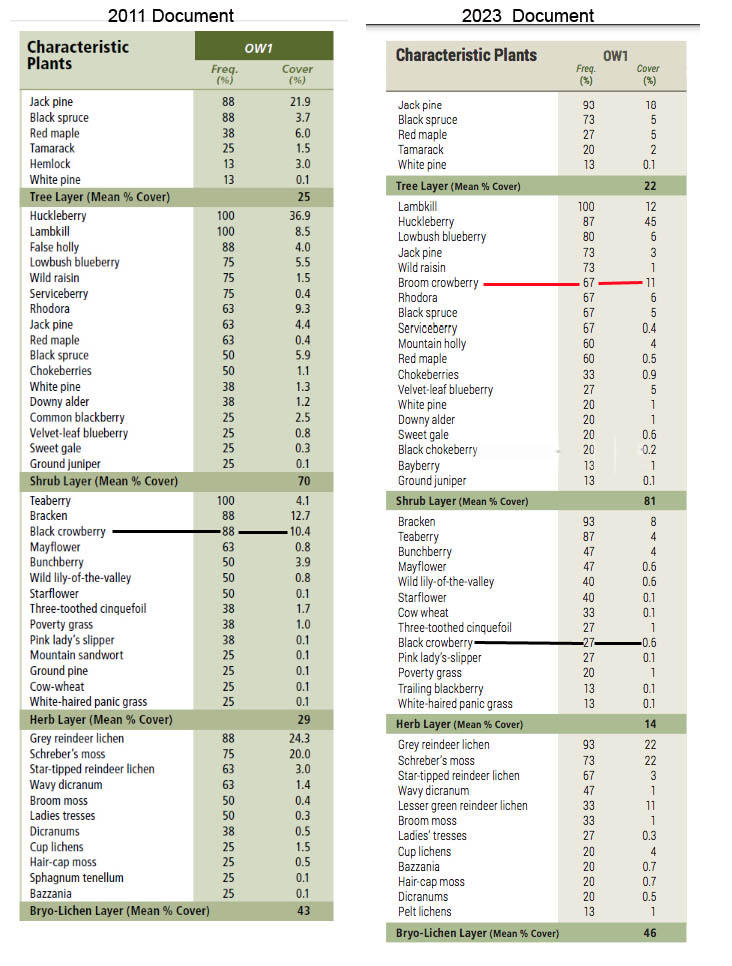As noted under Priority plant species and associations, some individual species are given formal protection in Nova Scotia; others may not be formally protected but are “Priority Species” that are noted and given special consideration in Environmental Assessments. Although there are now some systems for classifying “Plant Communities” or “Plant Associations” or “Vegetation Types”, rating them for conservation status is not well developed, and there is no formal legal protection for them in N.S.
The situation with regard to the “Jack Pine-Broom Crowberry Barrens” is further complicated by some apparent errors in the NS Provincial FVT (Forest Vegetation Type) OW1 – the NS FVT which corresponds most closely to the Jack Pine-Broom Crowberry Barrens described by Hill and Patriquin (2014). The Department of Natural Resources & Renewals recognized, at least in part, those errors, in 2013 but had not corrected them in the publicly available descriptions until 2023, and both sets of descriptions are still present on the NS Gov website – View Update Sep 13, 2024: Description of Forest Vegetation Type OW1 now highlights Broom Crowberry
——-
In our 2014 Report, Nick Hill and I described the occurrence of a plant community in the Williams Lake Backlands which we labelled “Jack Pine/Broom Crowberry Barrens”:
In this VT, Jack Pine occurs (i) as single or a few gnarled trees growing in cracks on rock barrens, (ii) in smallish (10-50 m across) treed patches with Jack Pine alone or dominated by Jack Pine and (iii) in more contiguous, larger patches interrupted by rock barrens or wetlands. Tree canopy cover ranges from less than 10% percent to about 60%. Big-toothed Aspen is the most common other tree in most mixed stands, followed by Red Maple, Wire & Paper Birch, Red & Black spruce. (Additionally, Jack Pines occur singly and in clusters in the Red Pine/Jack Pine/Broom Crowberry VT, and isolated Jack Pines occur in the Birch/Maple/Aspen VT, usually adjacent to their occurrence on Jack Pine/Broom Crowberry Barrens.) Broom Crowberry and Huckleberry are the most common associated shrubs, the Broom Crowberry occurring in edge areas on shallower soils, often with Reindeer Lichen, while Huckleberry occurs on deeper soils, growing tallest (to circa 1.5 m) where there is more exposure to the sun. Sheep Laurel may also occur, and in wet pockets, Huckleberry is replaced by one or more of Leatherleaf, Rhodora, Inkberry. – text from page 20 in 2014 Report.
Based on a review of literature and correspondence and discussion with botanists and plant ecologists (see Appendix C) we described the combination of Jack Pine and Broom Crowberry as “nationally unique & globally rare “, noting:
The restriction of Jack Pine/Broom Crowberry Barrens to the Atlantic Coast of Nova Scotia, and coastal NE Maine can be attributed to the unique coincidence of several factors in those areas:
• Jack Pine, a boreal species, is close to the southern extent of its range while Nova Scotia is at the northern extremity of the range for broom crowberry, an Atlantic Coastal Plain species.
• Both species require or do best in rapidly draining, acidic, nutrient-poor environments and are shade intolerant.
• Both species have specific adaptations to drought and fire and are stimulated by recurrent fire and tend to be eliminated if fire intervals are very short (perhaps less than 10-20 years) or very long (100+ years), although they may persist in the most exposed barrens habitats in which other stressors limit competition in the absence of fire.
• Broom Crowberry is restricted to areas not experiencing a high level trampling, ATVs & deer grazing.
We noted the similarity of the “Jack Pine/Broom Crowberry Barrens” to Nova Scotia Forest Vegetation Type OW1 (Jack Pine/Huckleberry/Black crowberry/Reindeer lichen) but with some significant differences:
The composition and site conditions for this VT are very similar to those for NSFVT OW1 (Jack Pine/Huckleberry/Black crowberry/Reindeer lichen), except that the latter cites Black Crowberry as characteristic, and Broom Crowberry occurring only occasionally. As well, the more fire-sensitive species listed under OW1 such as Hemlock and Bazzania trilobata (a liverwort) are not found in Jack Pine/Broom Crowberry Barrens in the WLB. Under the Canadian National Vegetation Classification system, many details of which are not yet publicly available, it corresponds to Subassociation A301b Corema conradii, in the Association A301 Jack Pine/Black Huckleberry – Black Crowberry/Three-toothed cinquefoil/reindeer Lichen Woodland (S.Basquill, Nova Scotia Dept. Natural Resources, personal communication).

From the description of OW1, accessed 29Oct2023
Click on image for larger version
In subsequent correspondence with Sean Basquill, Ecosystem Scientist at DNR/L&F/NRR, I (David P) commented that they seemed to have misidentified the crowberry in their type photo for Nova Scotia Forest Vegetation Type OW1, which is of a site at Blandford on the Aspotogon Peninsula; the photo is also in their ECL document, p 34. (I have been there a couple of times; some photos from a 2015 visit are available online). Sean acknowledged it is an error that needs to be corrected. As well, from re-examination of their sites, Sean B. concluded in 2022 that of the plots they used to characterize this FVT (Forest Vegetation Type), “Corema [Broom Crowberry] is present in >2/3 plots while Empetrum [Black Crowberry] is only there closer to the coast (~ 1/4 of plots).”
These subtleties are important as they underscore the conservation significance of the sites in the Backlands. From OW1 as it stands now (still not corrected in regard to the most common crowberry species**):
Ecological Features: This nationally unique, range-limited ecosystem is one of the least common VTs, largely isolated to cool dry ridges and hill tops. These sites are somewhat prone to lightning strikes that may help maintain jack pine dominance. The rocky woodland’s most remarkable features include its rarity, restricted distribution, and relatively specific environmental requirements. These collectively contribute to OW1’s high vulnerability, presenting unique conservation challenges. The Jack pine / Huckleberry / Black crowberry / Reindeer lichen woodland supports uncommon habitat conditions, but associated animal and lichen species are undocumented. This small patch ecosystem may provide plant habitat for mountain sandwort, red crowberry and a small group of flora with Atlantic Coastal Plain affinities (e.g. inkberry, broom crowberry and pine barren golden heather). It supports an open, sometimes stunted, canopy with abundant shrub and lichen cover. Productivity, tree age, canopy height and old growth potential are all low.
Sean Basquill commented in our correspondence of 2013, “I would speculate that the Corema expression of OW1 may be found as far west as the Aspotogan peninsula and east to Canso”. It is a statement with which Nick Hill and I agree based on our own observations. In regard to its occurrence in Maine (the only jurisdiction outside of NS for which occurrence of Jack Pine and Broom Crowberry in association has been reported), based on our review of the literature and correspondence (Appendix C), we concluded “it is clear that today, Jack Pine/Broom Crowberry associations are very rare in Maine.”
What I hope will eventually be clarified at a provincial level is whether all or most of the OW! sites away from the coast are exclusively Broom Crowberry sites (versus Broom Crowberry and Black Crowberry, or only the latter), also whether for all or most of them, there is evidence of a history of repeated fires as in the Backlands (re; 2014 Report), e.g., if most cones are serotinous, there is a lack of fire-intolerant species, and there are layers of charcoal in the soil on site or in a nearby wetland.
It is noteworthy that Empetrum nigrum is much more sensitive to fire than Corema conradii -see Lit; thus I would expect/hypothesize that OW! sites with only Corema conradii (and not Empetrum nigrium) would lack fire-intolerant species.
If indeed it is confirmed that all or most of the upland (versus coastal) sites are sites with only Broom Crowberry and they lack or have only casual occurrence of fire-intolerant species, that would render OW1 or its Corema conraii subassociation highly equivalent in nature to the – Pinus rigida – Quercus marilandica / Corema conradii Scrub (Association); features of that Association overlap with many of those of our “Jack Pine-Broom Crowberry Barrens”, except that Pinus rigida is the corresponding fire-stimulated pine, and it (the P. rigida Association) occurs on dry sandy soil rather than on thin soils over bedrock. The Pinus rigida – Quercus marilandica / Corema conradii Scrub (Association) has a Global Conservation Status of G2, and a New Jersey Status S1 and its conservation significance is well recognized. If the same type of recognition were given to our Jack Pine-Broom Crowberry Barrens, that could make a huge difference in our ability to protect them and in the public appreciation of them.
The Common Nighthawk, a Species-at-Risk in Nova Scotia, utilizes Jack Pine/Broom Crowberry Barrens in the Backlands as nesting habitat and thereby should, in principle at least, afford some level of protection legally.
See Good Forestry in the Granite State: 7.4 PINE BARRENS for an example of the type of management that is appropriate.
The Nova Scotia Nature Trust cited the Jack Pine/Broom Crowberry Barrens and its use by Common Nighthawk as a factor in their recent acquisition of a property in the Backlands:
This new property harbours globally rare Jack Pine/Broom Crowberry Barrens, as well as open woodlands, upland forests, forested wetlands, and open peatlands. The open barren and fire-disturbed habitats provide nesting opportunities for Common Nighthawk, which is known to breed in the area, and which is designated as a species of Special Concern under the federal Species at Risk Act and as Threatened under the Nova Scotia Endangered Species Act. Landlines, Apr 2, 2024
**UPDATE SEP 13, 2024: Description of Forest Vegetation Type OW1 now highlights Broom Crowberry
There are ongoing changes in the NS Gov, website and, for the moment at least, both older and newer documents containing descriptions Forest Vegetation Type OW1 exist.
The description of OW1 in newer document (published in 2023) differs significantly from description in the older document (published in 2011). Notably, the presence and relatively high abundance of Broom Crowberry is cited in the 2023 document, while this species x is not listed as a “characteristic plant” in the 2011 document, rather it is mentioned only as possibly occurring : “This small patch ecosystem may provide plant habitat for mountain sandwort, red crowberry and a small group of flora with Atlantic Coastal Plain affinities (e.g. inkberry, broom crowberry and pine barren goldenheather).”
Another difference: in the 2011 document, Hemlock is cited as one of the characteristic species, but it is not listed in the 2023 document.This is significant as hemlock is a very fire-averse species – so would not be expected in typical upland Jack Pine/Broom Crowberry Communities; and is not known as a stress tolerator sensu Grime – so would not be expected in the coastal barrens where Jack Pine and Broom Crowberry (both being stress tolerators AND fire adapted) can persist without fire because other stresses limit occurrence of competitors, sensu Grime.
THE 2011 DOCUMENT
Forest Ecosystem Classification for Nova Scotia Part I: Vegetation types (2010)
by Peter D. Neily, Seán Basquill, Eugene Quigley, Bruce Stewart, Kevin Keys
Published 2011
ISBN-13: 978-1-55457-413-1, ISBN: 1-55457-413-7
https://novascotia.ca/natr/forestry/veg-types/pdf/vegtypes.pdf
265 page PDF document
The Open Woodland Group which includes 6 VTs (OW1,2,3,4,5,6( is described on print pages 121-122
Description of OWI is on print pages 123 – 124. An extract:
OW1
Jack Pine / Huckleberry /black crowberry / Reindeer lichenPinus banksiana / Gaylussacia baccata /Empetrum nigrum / Cladina spp.n=8.Concept: This open coniferous woodland is characterized by jack pine canopy dominance, thin acidic soils and prominent reindeer lichen, black crowberry and huckleberry cover It is found on exposed rock ridges or thin glacial till, where it may co-occur with SP1 (Jack pine / Bracken – Teaberry forest) OW1 is typically on very-dry to dry sites, but occasionally occurs on moister soil, usually with thicker organic layers
Ecological Features: This nationally unique, range-limited ecosystem is one of the least common VTs, largely isolated to cool dry ridges and hill tops. These sites are somewhat prone to lightning strikes that may help maintain jack pine dominance. The rocky woodland’s most remarkable features include its rarity, restricted distribution, and relatively specific environmental requirements. These collectively contribute to OW1’s high vulnerability, presenting unique conservation challenges. The Jack pine / Huckleberry / Black crowberry / Reindeer lichen woodland supports uncommon habitat conditions, but associated animal and lichen species are undocumented. This small patch ecosystem may provide plant habitat for mountain sandwort, red crowberry and a small group of flora with Atlantic Coastal Plain affinities (e.g. inkberry, broom crowberry and pine barren golden heather). It supports an open, sometimes stunted, canopy with abundant shrub and lichen cover. Productivity, tree age, canopy height and old growth potential are all low.
THE 2023 DOCUMENT
© Crown copyright, Province of Nova Scotia, 2023
Forest Ecosystem Classification for Nova Scotia (2022): Field Guide
March 2023
ISBN 978-1-77448-495-1
Peter Neily, Sean Basquill, Eugene Quigley, Kevin Keys, Scott Maston, Bruce Stewart. Forestry and Wildlife Branch, Nova Scotia Department of Natural Resources and Renewables
Biodiversity Tech Report 2023-002
https://novascotia.ca/natr/wildlife/pdf/2023-002-biodiversity-tech-report.pdf
187 page PDF document
The Open Woodland Forest Group is described on pages 122-3
OW1 is described on pages 124-5. An extract:
OW1 Jack pine / Huckleberry – Broom crowberry / Reindeer lichen Pinus banksiana / Gaylussacia baccata – Corema conradii / Cladonia spp. n=15
Concept: This open coniferous woodland is characterized by jack pine canopy dominance, thin acidic soils and prominent reindeer lichen, broom crowberry and huckleberry cover. It is found on exposed bedrock ridges or thin glacial till, where it may co-occur with SP1 (Jack pine / Bracken – Teaberry forest). OW1 is typically on very-dry to dry sites, but occasionally occurs on moister soil, usually with thicker organic layers.
Ecological Features: This nationally unique, range-limited ecosystem is one of the least common VTs in Nova Scotia; it is largely isolated to cool dry ridges and hill tops. These sites are somewhat prone to lightning strikes that may help maintain jack pine dominance. The most remarkable features of this rocky
woodland include its rarity, restricted distribution, and relatively specific environmental requirements. These collectively contribute to high ecosystem vulnerability, presenting unique conservation challenges. The Jack pine / Huckleberry – Broom crowberry / Reindeer lichen woodland supports uncommon habitat conditions, but closely associated animal and epiphytic lichen species are undocumented. As a small-patch ecosystem,
it provides habitat for uncommon plants such as mountain sandwort, red crowberry and upland Atlantic Coastal Plain Flora (e.g. inkberry, broom crowberry and pine barren golden heather). Stands support an open, sometimes stunted, canopy with abundant shrub and ground lichen cover. Productivity, tree age, canopy height and old growth potential are all low.


